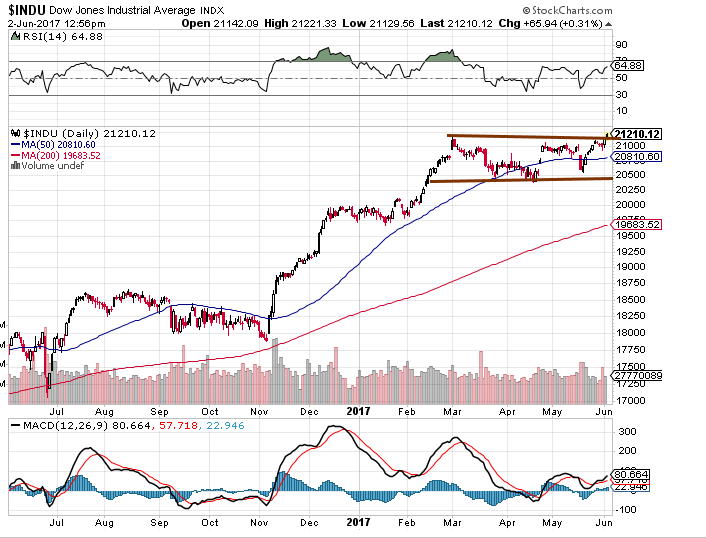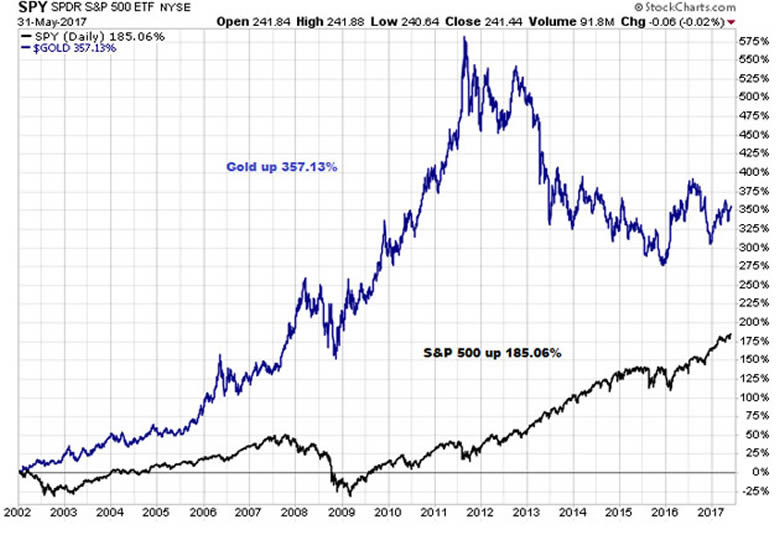Gold Keep Calm and Carry On
Commodities / Gold and Silver 2017 Jun 03, 2017 - 05:28 PM GMTBy: The_Gold_Report
 As precious metals expert Michael Ballanger ponders the current markets, he vows to "Keep Calm and Carry On." As I was walking through the shopping district of Kingston-on-Thames yesterday, I was wondering whether the locals had gotten the memo that the country remained on "High Alert" in light of the Manchester bombings. Here I was in the middle of an historic "village," walking across the Clattern Bridge (built in 1293) along with thousands of British shoppers, laughing and joking, sitting in pubs, talking about the rugby matches and generally going about their regular daily business as if nothing had happened. If I could have drawn little "thought balloons" above each and every person I observed, there would be one simple image of a raised middle finger everywhere. It was a wonderful, beautiful thing to witness.
As precious metals expert Michael Ballanger ponders the current markets, he vows to "Keep Calm and Carry On." As I was walking through the shopping district of Kingston-on-Thames yesterday, I was wondering whether the locals had gotten the memo that the country remained on "High Alert" in light of the Manchester bombings. Here I was in the middle of an historic "village," walking across the Clattern Bridge (built in 1293) along with thousands of British shoppers, laughing and joking, sitting in pubs, talking about the rugby matches and generally going about their regular daily business as if nothing had happened. If I could have drawn little "thought balloons" above each and every person I observed, there would be one simple image of a raised middle finger everywhere. It was a wonderful, beautiful thing to witness.

It should come as no surprise to anyone that knows British history that, as my father used to refer to it, this "little peanut of an island" ruled the world under the British Empire for most of the 19th century, ceding superpower status only after WWII to the U.S. and Russia after ruling the waves from the mid-1700s. It was in 1939 that the British government designed a poster (shown above) intended to prepare the citizenry by "shaping morale" for the imminent arrival of WWII with an increasingly bellicose Germany. While the poster was rarely displayed publicly, it epitomizes the "stiff upper lip" mentality of nation and explains a great deal of the majestic history of the country. Of course, I am talking up my book as all four grandparents were from England and many of my partner's first cousins are showing us around. For someone raised in a country barely 150 years old, to walk through churches built in the 1300s is awe-inspiring to say the least and intimidating at its best.
So as I attempt to make sense of today's markets with rampant interventions and blatant manipulations all designed to "shape morale" and keep the citizenry at once both complacent and behaved, it is as if the global banking cartel, working hand-in-glove with governments, are preparing for a cataclysm of sorts—a financial tempest that will make the "Blitz" of 1940-41 over London pale by comparison.
By intervening in the gold and silver markets, they have been able to eliminate their usual "canary-in-the-coal-mine" predictive natures and by propping up stocks, bonds and real estate, the public is now juggling multiple bubbles in a manner not unlike the Roaring Twenties or the Late Nineties. One by one, I see the "Big Money" (Warren Buffett, Paul Tudor Jones, Ray Dallio) exiting the stock and bond markets, and hedge funds managers galore returning capital to investors as opportunities shrink and risk escalates. When you think about the fact the CNBC's favorite ratings magnet, Warren Buffett, has now horded more then $100 BILLION "looking for better entry points," you have to ask yourselves why Facebook shares at $150 with a 38 P/E or Amazon at $995 trading with a 187 P/E are not finding themselves in the portfolio of Berkshire Hathaway. Can all of these very seasoned players in global markets be wrong at the same time?
The days of traditional fundamental analysis may have metamorphosed but they are by no means "different" in terms of outcomes. Just as surely as quantitative analysis has altered the technical aspects of securities analysis, all it has actually achieved is a temporary Band-Aid over a cancerous lesion. That cancerous lesion is the inability of corporations listed on the public markets to actually deliver earnings that can be paid out in the form of dividends over time. Algorithms that use pattern-recognition software to trade markets are specialists in rearranging Band-Aids over thousands of these hideous lesions but the time is rapidly approaching when events such as government default, social insurrection, recession, geopolitical upheaval including war, and/or natural disaster will wash away those Band-Aids, leaving multiple exposures of the ill health of the body.
As Paul Singer said recently: "We think that the low-volatility levitation magic act of stocks and bonds will exist until the disenchanting moment when it does not. And then all hell will break loose." That is precisely what I have been writing about through most of the last nine years dealing with serial intervention by central banks with checkered and sporadic periods of success and failure always finding solid FUNDAMENTAL reasons for trying to buy volatility ("VIX"/UVXY-US") or to buy puts on the S&P 500. Many such efforts occurred as recently as last November when I took out pre-election hedges to protect against a Trump victory. By 10:30 p.m. on the night of the election, I was clinking champagne glasses with my partner and dancing around the room with Fido the Dog as my hedges, had they opened right then and there, would have been ahead over tenfold. I went to bed with a wondrous array of sugar plums dancing in my head only to awake to the horror of stocks opening unchanged. Since then, I have refrained from trying to trade against the Cretins because it has become a mug's game of chronic head-banging and repeated rebukes.

That these interventions have cost us all a great deal of financial, intellectual, and emotional capital is in no way a sop to the significance of their criminality. However, the irony is that it has not affected the youngsters trained in the Millennial art of entitlement and self-indulgence. "Old people suffer bear markets; WE buy corrections" is the mantra of the day for tens of thousands of fuzzy-cheeked, selfie-obsessed traders and investors born during the first decade of the DotComs and the last decade of world-class mineral discoveries. The maddening part of it all is that the science of financial engineering studied and now-perfected by the dozens upon dozens of academics manning the halls of the global central banks have not only failed to experience the rapture of meeting payroll, they have never fully understood the delicate balance between the "real" economy and the "financial" economy.
Sadly, the latter has now overtaken the former in its significance not so much in its effect upon the bricks-and-mortar portion but more so in how it has grown to absolutely dominate policy, both fiscal and monetary. To wit, all simulative efforts enacted by the policy-makers, whether central bankers or elected officials, are now targeted toward bank collateral with the primary reflationary target being real estate.
Now that home prices in America are now approaching and in some cases surpassing the pre-GFC (2008) levels, the risk to the banking cartel has been mitigated by way of the reparation of the valuations of their collateral Achilles' Heel. Now that the risk of balance sheet implosion has been transferred from the banks to the consumers and by natural progression, the government, stock and bond prices are able to levitate and remain at bubble-like plateaus. An interesting question might be how gold and silver might have reacted since 2008 had the major portion of bank collateral been gold versus debt.
So as we plough forward into the spring of 2017, the model portfolio I constructed in 2001 and one which I actually bought in 2002 has surprised everyone by actually outperforming the S&P 500 by almost twofold but it should be emphasized that physical gold has been the premier performer while gold stocks have not done nearly as well. The fact that gold continues to be acquired by the Asian and European central banks is testimonial to the fragility of the currencies they are empowered to protect. As I sit here in the middle of England typing in an inn built in 941 A.D., it is easy to be intimidated by the sheer history of the establishment, of the village, of the region, and of the country. It is also easy to be intimidated by the constant and consistent bid in global equities in light of the slowing macro picture and looming interest rate hikes.

It is disheartening to watch gold and silver holdings sitting in limbo while stocks and crypto-currencies like Bitcoin are recording new all-time highs. It is depressing to watch bubble after bubble inflate while new ETFs are launching every day that lever up existing leveraged ETFs. It is frustrating to read emails from many seasoned long-term followers that are in full liquidation mode having been rendered powerless to any longer stomach the smug cockiness of the CNBC crowd. To sit on the crypto-currency sidelines while witnessing the manic elation of the Bitcoin Battalion is for me the ultimate in aggravation. All of my haranguing and whining and raging about the demise of the global currencies over the years was actually taken to heart by the master code-writers of the tech world, but instead of those massive tech profits migrating to gold and silver, they wound up CREATING their own alternative currency that has actually sucked capital AWAY from the precious metals because it was and is insulated from the grappling hooks of the interventionalists.
However, as glum as it may appear, it is never, EVER, truly "different" this time or any other time and all of the time-tested reasons for owning gold and silver are not only intact, they are more powerfully relevant today than ever before. I do not say this lightly; it took a trip to the birthplace of my forefathers in order to fully understand where we are in the bigger scheme. One of my lifelong heroes, Sir Winston Churchill, said "'Tact' is the ability to tell someone to 'Go to Hell' such that they actually look forward to the trip." He was a wonderful writer and was a published author long before he became a politician or a statesman. He had the uncanny ability to deliver scathing commentary upon foolishness. In an encounter with Lady Astor, she said to him: "Mr. Churchill, I think you are drunk!" to which he replied, "M'Lady, it is true that I am drunk but it is also true that you are UGLY. In the morning, I shall be sober BUT in the morning, you shall still be UGLY." Yet again, Churchill is accused of being a chauvinist pig with the following recontre: Lady Astor: "Oh, if you were my husband, I'd put poison in your tea." "Madame," Winston responded, "if I were your husband, I'd drink it."
I bring these nuances of human brilliance to the attention of my readers because I truly love "wit and intellect" with a passion. When you are forced to sit back and grind your back teeth as others around you are celebrating the ownership of stocks at valuation levels surpassing the highs of 2001 and 2007 and 1987, you must have a "Fall Back" position in order to maintain sanity. As we are not yet able to hold up a mirror and prove to the world that we have solved the puzzle surrounding the global debasement of currency purchasing power, it can in no way be seen as an analytical failure of the precious metals. Alternatively, we have to think in the same manner as Sir Winston. We have to think as independently and as reconstructively as he did when he told the British people what they should expect in the event that they could rebuff the German Luftwaffe in 1940-41. We as gold and silver investors have to think as adaptably as did Churchill when he told the British people that this would be "their finest hour."
In this era of invasive central planning and congenital bubble-blowing, it isn't easy to invest as a contrarian. It is even more painful to watch friends and colleagues dismiss overvaluation arguments because "it's working." And it is almost surreal to watch naive and unsophisticated Canadian "investors" sitting with $3 million in mortgage debt, five rented properties and plans to "buy more" while attending seminars and conferences with paid actors revving up overexuberant crowds.
Sanity can only be kept by remembering the mistakes of the past; focusing on time-tested methods; and by remaining vigilant. To do otherwise would be folly of great impact and consequence. When investing in today's hyperventilating markets, I will vow to "Keep Calm and Carry On."
Now it's off to the Emerald Isle.
Originally trained during the inflationary 1970s, Michael Ballanger is a graduate of Saint Louis University where he earned a Bachelor of Science in finance and a Bachelor of Art in marketing before completing post-graduate work at the Wharton School of Finance. With more than 30 years of experience as a junior mining and exploration specialist, as well as a solid background in corporate finance, Ballanger's adherence to the concept of "Hard Assets" allows him to focus the practice on selecting opportunities in the global resource sector with emphasis on the precious metals exploration and development sector. Ballanger takes great pleasure in visiting mineral properties around the globe in the never-ending hunt for early-stage opportunities.
Want to read more Gold Report interviews like this? Sign up for our free e-newsletter, and you'll learn when new articles have been published. To see a list of recent interviews with industry analysts and commentators, visit our Streetwise Interviews page.
Disclosure:
1) Statements and opinions expressed are the opinions of Michael Ballanger and not of Streetwise Reports or its officers. Michael Ballanger is wholly responsible for the validity of the statements. Streetwise Reports was not involved in any aspect of the article preparation. Michael Ballanger was not paid by Streetwise Reports LLC for this article. Streetwise Reports was not paid by the author to publish or syndicate this article.
2) This article does not constitute investment advice. Each reader is encouraged to consult with his or her individual financial professional and any action a reader takes as a result of information presented here is his or her own responsibility. By opening this page, each reader accepts and agrees to Streetwise Reports' terms of use and full legal disclaimer. This article is not a solicitation for investment. Streetwise Reports does not render general or specific investment advice and the information on Streetwise Reports should not be considered a recommendation to buy or sell any security. Streetwise Reports does not endorse or recommend the business, products, services or securities of any company mentioned on Streetwise Reports.
3) From time to time, Streetwise Reports LLC and its directors, officers, employees or members of their families, as well as persons interviewed for articles and interviews on the site, may have a long or short position in securities mentioned. Directors, officers, employees or members of their immediate families are prohibited from making purchases and/or sales of those securities in the open market or otherwise from the time of the interview or the decision to write an article, until one week after the publication of the interview or article.
© 2005-2022 http://www.MarketOracle.co.uk - The Market Oracle is a FREE Daily Financial Markets Analysis & Forecasting online publication.



